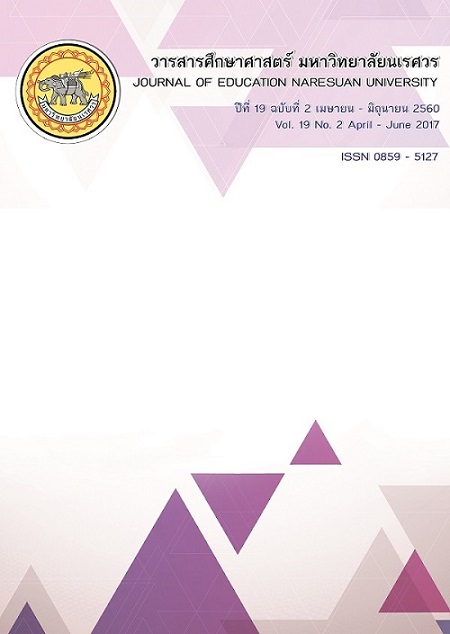การวิจัยปฏิบัติการเพื่อพัฒนาความคิดสร้างสรรค์ รายวิชาคอมพิวเตอร์ ของนักเรียนชั้นประถมศึกษาปีที่ 5 โรงเรียนบ้านน้ำคิว สังกัดสำนักงานเขตพื้นที่การศึกษาประถมศึกษาเลย เขต 1
Main Article Content
Abstract
การวิจัยปฏิบัติการครั้งนี้มีวัตถุประสงค์เพื่อ 1) เพื่อศึกษาสภาพปัญหาการจัดกิจกรรมการเรียนการสอนเพื่อพัฒนาความคิดสร้างสรรค์ 2) เพื่อศึกษาความคาดหวังและแนวทางการพัฒนาความคิดสร้างสรรค์ 3) เพื่อศึกษาผลการพัฒนาความคิดวิชาคอมพิวเตอร์ โดยเปรียบเทียบความคิดสร้างสรรค์ระหว่างก่อนและหลังการพัฒนาและเปรียบเทียบความคิดสร้างสรรค์กับเกณฑ์ร้อยละ 70 4) เพื่อศึกษาความพึงพอใจของนักเรียนชั้นประถมศึกษาปีที่ 5 โรงเรียนบ้านน้ำคิว สำนักงานเขตพื้นที่การศึกษาประถมศึกษาเลย เขต 1 ต่อการจัดกิจกรรมการเรียนรู้เพื่อพัฒนาความคิดสร้างสรรค์จากการประยุกต์ใช้งานโปรแกรมประมวลผลคำ (Microsoft Word) กลุ่มตัวอย่างจำนวน 6 คน เครื่องมือที่ใช้ในการวิจัย ประกอบด้วย แบบวัดความคิดสร้างสรรค์ แบบสัมภาษณ์ แผนการจัดการเรียนรู้และแบบสังเกตพฤติกรรม การวิเคราะห์ข้อมูล ได้แก่ ร้อยละ ค่าเฉลี่ย ส่วนเบี่ยงเบนมาตรฐานและสถิติวิลคอกซัน ผลการวิจัย พบว่า 1) สภาพปัญหา พบว่า นักเรียนขาดความคิดสร้างสรรค์ ขาดความคิดคล่องแคล่วในการใช้คอมพิวเตอร์ การจัดกิจกรรมการเรียนการสอนบางวิชาไม่ส่งเสริมความคิดสร้างสรรค์ ผลการวัดความคิดสร้างสรรค์ก่อนการพัฒนานักเรียนทุกคนไม่ผ่านเกณฑ์ร้อยละ 70
2) ความคาดหวัง พบว่า นักเรียนควรมีพฤติกรรมใฝ่เรียนรู้ กล้าคิด ควรสร้างผลงานให้แปลกใหม่โดยประยุกต์ใช้งานโปรแกรมประมวลผลคำ (Microsoft Word) แนวทางการพัฒนา พบว่า ควรส่งเสริมและสนับสนุนนักเรียนให้กล้าแสดงความคิดนำเสนอผลงาน ฝึกให้นักเรียนวางแผนการทำงาน ใช้คำถามกระตุ้นให้นักเรียนเกิดความคิดสรรค์ 3) ผลการพัฒนาความคิดสร้างสรรค์หลังได้รับการพัฒนาสูงกว่าก่อนการพัฒนาอย่างมีนัยสำคัญทางสถิติที่ระดับ .05 เมื่อเทียบกับเกณฑ์ร้อยละ 70 นักเรียนมีผลการพัฒนาเพิ่มขึ้นร้อยละ 100 4) นักเรียนและผู้มีส่วนเกี่ยวข้องมีความพึงพอใจต่อการจัดกิจกรรมการพัฒนาความคิดสร้างสรรค์อยู่ในระดับมาก
ACTION RESEARCH ON CREATIVE THINKING DEVELOPMENT OF COMPUTER SUBJECT IN PRATHOMSUKSA 5 STUDENT AT BANNUMQUE SCHOOL UNDER THE OFFICE OF LOEI PRIMARY EDUCATIONAL SERVICE AREA OFFICE 1
The purposes of this action research were 1) to study the state and problems of teaching and learning activity management for creative thinking development, 2) to inquire the expectation and guidelines for creative thinking development, 3) to explore the result of the thinking development in computer subject by comparing the creative thinking between before and after development, and then comparing the creative thinking with the 70 percent criteria, and 4) to obtain the satisfaction of Prathomsuksa 5 students at Bannamque school, under the Office of Loei Primary Educational Service Area Office 1 with the learning activity management to develop the creative thinking from applying the Microsoft Words program. The samples of 6 people. The research tools were the creative thinking test, interview form, the learning management plan and the observation form. The data were analyzed by percentage, mean, standard deviation and the Wilcoxon signed- ranks test. The results were 1) the state found that the students were lack of creative thinking, assertiveness; they were lack of the nimbleness on using computer to create the creative works. The result showed that all of students did not pass the 70 percent criteria, 2) the expectation was obviously found that the students should have the inquiry learning behavior, assertiveness and challenge new creativeness in use Microsoft words program. The guideline was suggested that the students should be promoted and supported for self-confidence and assertiveness for their work presentation, 3) the result of the creative thinking after development was higher than before development with the statistical significance at .05 level. Comparing the creative thinking with the 70 percent criteria, the development result was increased 100 percent, and 4) the students and the stakeholders were satisfied at a high level with the activity management to develop the creative thinking.
Article Details
The owner of the article does not copy or violate any of its copyright. If any copyright infringement occurs or prosecution, in any case, the Editorial Board is not involved in all the rights to the owner of the article to be performed.


